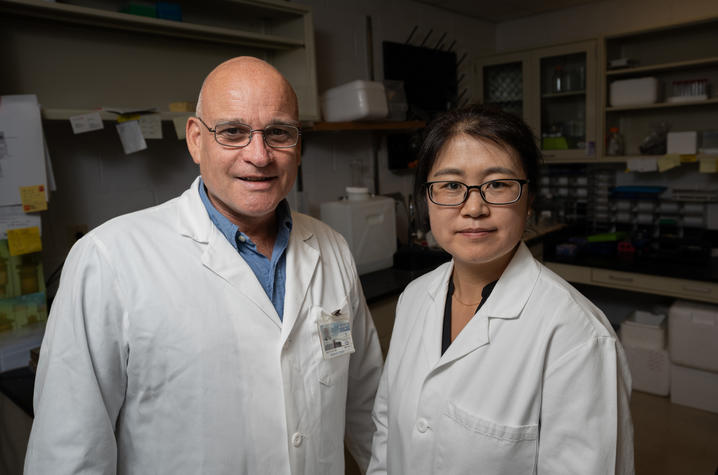UK researchers 1st to show multiple sclerosis drug can be used as Alzheimer’s therapy
LEXINGTON, Ky. (Sept. 1, 2023) — A team of researchers at the University of Kentucky has found that a drug used to treat multiple sclerosis (MS) is potentially effective as a therapy for Alzheimer’s disease.
Alzheimer’s is a progressive and irreversible neurological disorder. It’s estimated 6.2 million Americans aged 65 and older are living with the disease that affects cognitive function, memory and behavior.
“We stand at the threshold of a critical endeavor to develop new treatment strategies against Alzheimer’s disease,” said Erhard Bieberich, Ph.D., a professor in the Department of Physiology in the UK College of Medicine. “We’ve uncovered that a medication already on the market, ponesimod (brand name ‘Ponvory’), can reduce one of the hallmarks of this disease: neuroinflammation.”
Bieberich is the principal investigator on a series of grants from the National Institute on Aging (NIA) of the National Institutes of Health (NIH) and U.S. Department of Veterans Affairs that funded the study. The findings were published in the journal eBioMedicine, part of The Lancet Discovery Science in August.
The team studied ponesimod, an oral medication that the U.S. Food and Drug Administration (FDA) has approved to treat relapsing forms of MS. The medication reduces inflammation in the brain by targeting a specific receptor in the immune system to help regulate the body’s response and prevent it from attacking the central nervous system. This receptor is activated by a lipid termed sphingosine-1-phosphate, the function of which is studied by the Bieberich lab.
“We are the first to show that ponesimod is effective in a mouse model for Alzheimer’s disease,” said Bieberich. “Since this drug is already in clinical use for therapy of relapsing multiple sclerosis, it is immediately available to be used in Alzheimer’s disease therapy as well.”
UK researchers homed in on a specific type of cell found in the central nervous system called microglia. The cells have several functions in our bodies, including regulating inflammatory responses in the central nervous system — the brain and the spinal cord.
Dysfunctional microglia are connected to neurodegenerative diseases like Alzheimer’s because those cells help clear out the buildup of abnormal protein deposits in the brain — a distinct characteristic of the disease. Those buildups disrupt the communication between the brain’s nerve cells and eventually die off.
“The clearance of those proteins is an important target for Alzheimer’s disease therapy,” said Zhihui Zhu, Ph.D., first-author of the study and one of the scientists in Bieberich’s lab. “In our study, we reprogrammed microglia into neuron-protective cells that clean up toxic proteins in the brain, reduce Alzheimer’s neuroinflammatory pathology, and improve memory in the mouse model.”
As part of the project, researchers studied mice with specific genetic strains that express the major features of Alzheimer’s in their brains. They treated half of the mice with ponesimod and measured specific cell activity in the brain. The mice’s spatial memory was also tested through a maze behavior test.
“That specific test is a measure of the spontaneous tendency of the mice to alternate their free choices to enter the two arms of the maze,” said Zhu. “Our tests indicate ponesimod rescues attention and working memory in mice with advanced Alzheimer’s pathology.”
Scientists also worked with UK’s Alzheimer’s Disease Research Center within the Sanders-Brown Center on Aging to obtain human brain samples to study. The data collected from those tests were consistent and also indicated ponesimod can be used as a therapy for Alzheimer’s.
“Neuroinflammation is a hallmark of Alzheimer’s, one of the major causes for disease progression and a promising target for therapy,” said Bieberich. “Our study shows strong experimental evidence that ponesimod may be a therapeutic drug, which not only reduces neuroinflammation but also enhances the clearance of neurotoxic proteins in the brain in middle and late-stage Alzheimer’s.”
You can read the entire study online here.
Research reported in this publication was supported by the National Institute on Aging of the National Institutes of Health under Award Numbers R01AG064234, RF1AG078338 and R21AG078601. The content is solely the responsibility of the authors and does not necessarily represent the official views of the National Institutes of Health.
This material is based upon work supported by the Department of Veterans Affairs, Veterans Health Administration, Office of Research and Development. The views expressed in this article are those of the authors and do not necessarily reflect the position or policy of the Department of Veterans Affairs or the United States government.
As the state’s flagship, land-grant institution, the University of Kentucky exists to advance the Commonwealth. We do that by preparing the next generation of leaders — placing students at the heart of everything we do — and transforming the lives of Kentuckians through education, research and creative work, service and health care. We pride ourselves on being a catalyst for breakthroughs and a force for healing, a place where ingenuity unfolds. It's all made possible by our people — visionaries, disruptors and pioneers — who make up 200 academic programs, a $476.5 million research and development enterprise and a world-class medical center, all on one campus.







